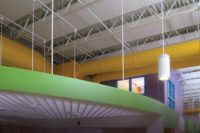
Delayed
drywall installations resulting from untimely completion of the roofing and
waterproofing contractor.
Out of several issues that prevent subcontractors from getting their full pay from work on a project, the one that typically rears its ugly head is the loss of productivity. Subcontractors oftentimes have no control over the job site environment and are subject to productivity delays caused by others and other factors. So, how about a tool that helps combat these losses?
That is exactly what a team-lead by the Northwest Wall and Ceiling Bureau-did in composing the study “Impacts to Labor Productivity in Steel Framing and the Installation and Finishing of Gypsum Wallboard.”
The NWCB, in cooperation with other wall and ceiling industry associations in the West (such as the Northwest Wall & Ceiling Contractors Association, Association of Wall and Ceiling Contractors of Oregon and Southwest Washington, Northern California Drywall Contractors Association and Western Wall & Ceiling Contractors Association) last year published a study focusing on the impacts on labor productivity on steel framing, and drywall hanging and taping.

Framing
inspection failure due to improper MEP installations.
Because labor productivity is the single greatest variable affecting the construction contractor’s cost of production and profitability, the findings of the study can help contractors get compensated for losses due to change orders and other factors out of their control.
“Why it [the study] got started is wall and ceiling contractors were having challenges with the general contractor and owner on getting paid for extra or loss of productivity time that they had to do,” says Bob Drury, executive director of the NWCB.
Drury says in order to make a labor impact study valid, an independent source has to do this research.
“In a court of law, it has to be an academic document. In other words, we hired a consultant and we hired Portland State University,” says Drury.

MEP
installation not within the partition cavity, preventing scheduled installation
of drywall.
When asked why the study was written, one of the study’s writers, Gerald H. Williams, Jr., PhD, P.E. of Construction Research Inc., out of Portland, says drywall activities make up approximately 10 percent of construction costs, and between 60 to 70 percent of metal framing, drywall, tape and finish work is direct application labor.
“This means that labor productivity normally has the greatest potential impact on the drywall contractor’s cost of production. Granted, the run-up in steel prices in 2004 and 2005 also had a great impact but that was an unprecedented event,” says Williams. There have been no previous studies of labor productivity or factors impacting labor productivity in the metal stud framing, drywall, tape and finishing trades, he says.
This study was done to research what factors actually impact labor productivity in the framing and drywall trades and to what extent. The findings provide the link between an event or condition on a project (such as crowding or work fragmentation) and its negative impact on labor productivity, Williams says.
In a project-management setting, a party that is considering whether or not to make changes to an as-bid construction schedule that would affect metal-stud framing and the installation and finishing of drywall, would be well served by reading the study due to the consequences of such a change, says Alan Bornstein, an attorney with Jameson, Babbitt, Stites, & Lombard, P.L.L.C. in Seattle.
“The study describes the interrelationship of metal-stud framing and the installation and finishing of gypsum wall board with other trades in a typical construction sequence on a commercial project,” he says. “When that typical construction sequence is altered, it has a ripple effect not only upon the work of the drywall contractor, but also on the other trades whose work is interrelated, such as the mechanical, electrical, and plumbing trades. The study describes how that ripple effect makes labor-typically the largest cost component on any construction project-inefficient and therefore, more expensive as a project cost.”
In a claims setting, where the drywall contractor believes that he has suffered a labor-productivity loss, the drywall contractor now has access to a study to help support his particular claim, Bornstein continues.
“The study is no substitute for proof,” he says. Everyone involved in the production of the study confirm that it is helpful only where the drywall contractor can establish that another party, such as the GC or other trades, caused obstacles in the construction schedule and that the labor inefficiencies were not of its own making.
Jim Dunham, vice president of field operations with Vanderlip & Co. Inc., of Redmond, Wash., and also sits on the NWCB’s Board of Directors as president, says: “I think the main factors in loss of productivity are any interruption of flow of work: to start an area of work, stop, remobilize, start-again (a new crew will have a certain learning curve to get a flow going); trying to work in the same area as other trades always leads to conflicts and lack of productivity; adding more workers to an area than the area can handle to try and catch up on a slipping schedule.”

Out
of sequence HVAC installation, preventing access for drywall installation.
In theory, the study sounds great. But does it work for the contractor, who has to count on the fact that the GC or owner will actually read the manual?
“In theory, this study will support the subcontractors’ claims that being forced into these situations that there is merit to the fact that they are losing productivity, time and money,” says Dunham.
Since the study has become available, he’s noticed that general contractors and owners are more willing to discuss possible production losses as they occur.
“Recently we had a project that the door frames had not arrived on the project and were not installed,” Dunham says. “The contractor wanted us to frame that area because the schedule showed that area to have been already framed. We were able to convince the general that even though there would be little or no added footage to that area, coming back to complete the framing at those door jamb areas would not be completed for the same hours or production we bid the project. We were given a change order to cover our lost hours.”
According to James Kahler, vice president of Northwest Partitions Inc., of Kent, Wash., the study’s power is that owners and contractors listen because it is a published statistical study that incorporates a large sampling of projects (226 polled) from several wall and ceiling contractors.
But has the study had a direct impact working for its subcontractors? Yes, absolutely says Kahler.
“We were involved in a project that would not allow the completion date to be pushed out even though the project required some redesign early on,” he says. “This owner-delay required the project schedule be compressed. The compressed schedule necessitated overtime, out-of-sequence work, trade stacking, ramp-ups and ramp-downs and diluted supervision for us. The owner originally proposed only paying the overtime premium. With the assistance of the study, Northwest Partitions was able to prove entitlement, avoid litigation, and resolve the matter amicably, which resulted in a change order for us in excess of $85,000. It helped that we had our documentation in place early on and were continually communicating the potential negative labor impacts to the GC and owner. The study was the icing on the cake.”
According to Drury, the study is not just relevant to subcontractors out west but is a tool that is available from the NWCB for contractors throughout North America.
“This document is a tool for the contractor and his legal team/consultants to use so they can show loss of productivity-i.e. money,” says Drury.
Williams double-downs on Drury’s sentiment: “One thing I think that needs to be recognized is that drywall contractors, particularly on larger projects, need to be aware of the factors we studied, understand their contractual notice requirements, and keep good productivity records. In the end, the study proves causation but it can only be used as a broad guide to the amount of impact. Contractors have to keep good job-cost records so that an analyst can prove the magnitude of impact.”
The study is available from the NWCB. Visit www.nwcb.org. W&C







